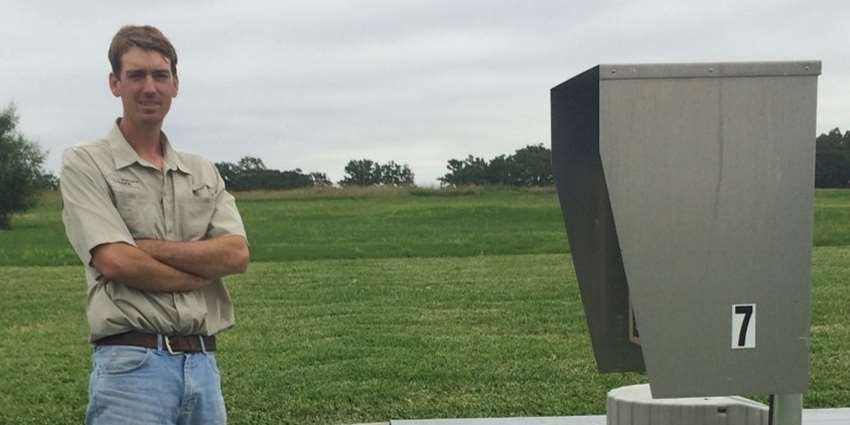Charles Fontanier, a doctoral student in Texas A&M University’s Water Management and Hydrological Sciences Program, believes that most Texans want to conserve water, even when it comes to watering their lawns. He hopes his research helps them understand that they can save water and have their lawns too.
“I think most people want to conserve water and are willing to have a marginally lower quality lawn to do so,” Fontanier said. “I hope the public can use my research to recognize that Texas lawn grasses are hardy and will tolerate temporary drought stress. Even if it turns off-color or loses density, recovery is likely when seasonal rains return.”
He is conducting research on St. Augustine grass and surface water runoff at the Texas A&M Turfgrass Field Lab, in an effort to improve irrigation management of lawns.
Fontanier, who received his master’s and bachelor’s in agronomy from Texas A&M, is a 2014–2015 Mills Scholarship recipient. These scholarships, funded by the W.G. Mills Scholarship Memorial Endowment, help graduate students at Texas A&M, Texas A&M at Galveston and Texas A&M at Qatar who are pursuing water-related research with the potential to help Texas solve future water problems.
Fontanier said while lawn water requirements change from year to year depending on natural variability in rainfall, temperature and humidity, the historical average-based irrigation recommendation is that lawn managers or homeowners should water their lawns 1 inch a week.
“We wanted to test how successful we could be simply using the annual average of around 1 inch a week to set sprinkler run times,” he said. “Using this common average, the manager would only need to adjust controller run times two to three times per year.”
Fontanier said his research suggested that leaving the sprinkler controllers set at watering around 1 inch per week resulted in the grass being under-watered by as much as 20 percent during a dry year, based on real-time weather data to predict actual plant needs, but the grass maintained an acceptable appearance. The grass was over-watered by as much as 20 percent in wet years.
“Ultimately, the common adage that you should water your lawn 1 inch per week appears to be fairly reliable for the months of June, July and August,” he said.
One of the strategies used in his research was adaptive irrigation management. “That is, irrigation strategies should be targeted such that we get the most out of each drop of water applied,” he said.
“The question becomes, how little water can we apply in the summer and still maintain adequate density of the grass to spur recovery during cooler, wetter times of the year?” Fontanier said. “Our data indicate that we can use 50 percent of lawn water requirements, or about one-half inch a week, and still have enough live plants to allow complete recovery before winter.”
While conserving water is paramount, especially in the midst of drought and supply shortages, Fontanier said it is also important to remember that turf is a resource and we should consider the unintended consequences of severe water conservation practices for drought-damaged grass on soil moisture, surface runoff and the chemistry of the runoff water.
“For example, as a lawn loses density and becomes desiccated, what happens to the infiltration capacity and nutrient cycling of that ecosystem?” he asked. “Our data suggest that the benefits of maintaining lower soil moisture conditions of droughty lawns exceed the impact of temporary changes to the turf canopy. That is, as long as we keep some grass alive, having drier soils is more effective at improving infiltration than maintaining a high density lawn.”
When it does rain in summer, he said, having drier soil will lead to less runoff of the water. “That means lawn mangers and homeowners are able to keep more of their water on-site instead of losing it to the storm drains.”
Fontanier credits his mentors from Texas A&M’s Department of Soil and Crop Sciences, Dr. David Chalmers, professor emeritus, and Dr. Richard White, professor, with helping him realize the value and need for this research. Once he graduates, Fontanier hopes to become an assistant professor at a university.


